Wondering about the right e-bike tire pressure? You can check your tire’s sidewall, but here’s a quick guide:
|
Tire Type |
Recommended PSI Range |
Best For |
|---|---|---|
|
Mountain Tires |
30 - 40 PSI |
Off-road, rough terrain |
|
Road Tires |
50 - 60 PSI |
Smooth, paved surfaces |
|
Hybrid Tires |
50 - 60 PSI |
City, mixed-use paths |
Choosing the correct tire pressure keeps your ebike safe, boosts performance, and helps your battery last longer. When you keep your electric bike tire pressure in the right range, you can ride faster, avoid flats, and even extend your tire’s life by up to 20%. Small changes in ebike tire pressure make a big difference in how your electric bike feels and rides.
Key Takeaways
-
Keep your e-bike tires inflated within the recommended PSI range printed on the tire sidewall for safety and better performance.
-
Adjust tire pressure based on your weight, cargo, riding terrain, and weather to improve comfort, grip, and battery life.
-
Check your tire pressure regularly with a reliable gauge, especially before rides and when temperatures change.
-
Avoid over-inflating or under-inflating tires to prevent flats, uneven wear, and unsafe handling.
-
Use a good pump and follow a simple maintenance routine to extend tire life and enjoy smoother, safer rides.
PSI Ranges
E-bike Tire Types
When you look at e-bike tires, you’ll notice they come in a few main types. Each type has its own design and purpose, which affects how much air you should put in. Most e-bike tires are wider than regular bike tires. This helps them handle the extra weight and speed of an electric bike. You’ll find three main tire constructions:
|
Tire Construction |
Typical PSI Range |
Common Use |
|---|---|---|
|
Clincher |
Road, city, hybrid |
|
|
Tubular |
Up to 130 PSI |
Racing, performance road |
|
Tubeless |
30 - 50 PSI |
Mountain, fat tire, rough terrain |
Tip: Most e-bike tires use clincher or tubeless designs. Tubeless tires let you run lower pressures for better grip and comfort, especially on rough trails.
You’ll also see different tire widths. Fat tire electric bikes have tires that are 4 inches wide or more. These need much lower pressure—usually between 10 and 30 PSI—so you get more grip on sand, snow, or loose dirt. Standard e-bike tires are narrower and need higher pressure for smooth rides on pavement.
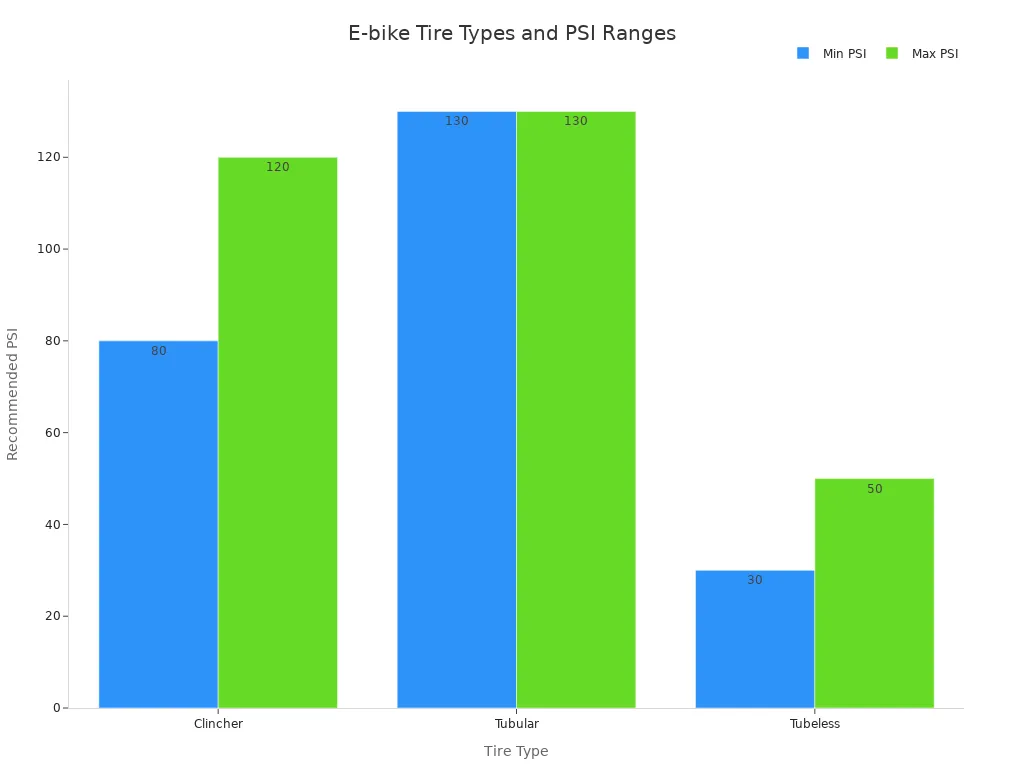
Recommended PSI
You might wonder, “How do I know the right PSI for my tires?” The answer is usually right on the tire itself. Most e-bike tires have the recommended pressure range printed on the sidewall. This is your starting point for safe and smooth rides.
But the ideal tire pressure isn’t just about what’s printed on the tire. You need to think about a few things:
-
Tire type and size: Fat tire electric bikes need lower PSI for grip. Standard tires need higher PSI for speed and efficiency.
-
Manufacturer’s recommendations: Always check the sidewall or your owner’s manual for the recommended pressure range.
-
Riding conditions:
-
If you ride on smooth city streets, use higher pressure to roll faster.
-
For rough trails or off-road, lower the pressure a bit for better traction and comfort.
-
If it’s cold outside, your tire pressure drops. Hot weather makes it go up. Check your tires more often when the temperature changes.
-
-
Rider weight and cargo: If you carry a heavy backpack or ride with extra gear, add a few PSI to keep your tires from squishing too much.
Note: Start with the recommended pressure range, then adjust in small steps. Try adding or letting out 5 PSI at a time until your ride feels just right.
Here’s a quick list to help you remember what affects your tire pressure recommendations:
-
Tire width and type (fat tire electric bike vs. standard)
-
Manufacturer’s recommendations on the sidewall
-
Where and how you ride (city, trail, off-road)
-
Weather and temperature
-
Your weight and any cargo
Getting the optimal PSI means your ebike will feel stable, safe, and fun to ride. You’ll also get better battery range and avoid flats. Regularly checking your e-bike tire pressure is one of the easiest ways to keep your electric bike running its best.
Why Tire Pressure Matters
Safety and Handling
You want your ebike to feel safe and easy to control. The right tire pressure helps you stay steady, even when you turn or stop quickly. If your tires have too much air, they can feel hard and bouncy. This makes your ebike less stable and can even cause a blowout, especially if you ride fast or on hot days. If your tires do not have enough air, they can feel slow and squishy. This makes it hard to steer and can lead to pinch flats or even crashes.
Here are some important points about tire pressure and safety:
-
Over-inflated tires can burst and lose grip, making your ebike harder to handle.
-
Under-inflated tires can get flats more easily and make your ride feel sluggish.
-
Both too much and too little tire pressure can increase your risk of accidents.
-
Regularly check your tire pressure before you ride, especially if the weather changes.
-
Use a good pump with a gauge to get the right pressure every time.
Performance and Range
When you keep your ebike tires at the right pressure, you get the best performance. Your ebike rolls faster and uses less battery power. If your tire pressure is too low, your ebike has to work harder. This means your battery drains faster and you cannot go as far. If you keep your tires properly inflated, you will notice smoother rides and longer trips on a single charge. Even a fat tire electric bike needs the correct tire pressure for the best grip and speed.
Keeping your tire pressure in the recommended range helps your ebike go farther and saves battery life.
Tire Longevity
Tire pressure also affects how long your tires last. If you ride with the wrong pressure, your tires wear out faster. Over-inflated tires can wear down in the middle, while under-inflated tires wear on the sides and can get damaged more easily. The effects of incorrect tire pressure include uneven wear, more flats, and even blowouts. By checking your tire pressure often and following the manufacturer’s advice, you help your tires last longer and save money in the long run.
Find Correct Tire Pressure
Check Sidewall and Manual
You want to get the most out of your ebike, so start by finding the correct tire pressure. The easiest way is to look at the sidewall of your tire. You’ll see numbers like “622-47” or “27.5×2.4.” These numbers show the size, but you should also look for a PSI range, such as “Inflate to 45–65 PSI.” Some tires even have special markings for electric bike use, like “E-25” or “E-bike Ready.” These markings mean the tire can handle the extra weight and speed of an ebike.
Always check both the minimum and maximum PSI on the sidewall. This range gives you a safe zone for inflation. If you want more details, grab your owner’s manual. Manufacturers often include tire pressure recommendations for your specific model. These guides help you fine-tune your ride for comfort, safety, and efficiency. You’ll also find tips for different tire types, like urban, mountain, or fat tire ebikes.
Tip: Use a quality pressure gauge to check ebike tire pressure. This tool helps you stay within the recommended pressure range and avoid guesswork.
Adjust for Weight and Terrain
You don’t ride the same way every day, so you need to adjust psi to match your needs. Your weight, any cargo, and the type of ground you ride on all affect tire pressure. Heavier riders should add 2-3 PSI for every 20 pounds over 160 pounds. If you carry a backpack or groceries, add 3-5 PSI to support the extra load. This keeps your tires from squishing too much and helps prevent flats.
Terrain matters, too. On smooth, dry pavement, use higher pressure for less rolling resistance and more speed. If you ride on wet or loose surfaces, lower the pressure by 2-3 PSI for better grip. For rough trails or gravel, drop the pressure a bit to absorb bumps and keep your ride comfortable. Fat tire ebikes need special care—use 15-30 PSI on pavement, but drop to 5-12 PSI for sand or snow.
Here’s a handy table to help you adjust psi for different factors:
|
Factor |
How to Adjust PSI |
|---|---|
|
Rider Weight |
Add 2-3 PSI per 20 lbs over 160 lbs |
|
Cargo Load |
Add 3-5 PSI for extra cargo |
|
Smooth Pavement |
Use higher pressure within the recommended range |
|
Rough Terrain |
Lower pressure by 2-3 PSI for better traction |
|
Wet/Loose Ground |
Lower pressure by 2-3 PSI |
|
Fat Tire Ebike |
15-30 PSI (pavement), 5-12 PSI (sand/snow) |
You don’t have to guess the ideal tire pressure. Start near the middle or just below the max PSI listed on your tire. Then, adjust psi in small steps—try 5-10 PSI at a time. Take a short ride and see how your ebike feels. If the ride feels too bumpy, let out a little air. If it feels slow or squishy, add some air. Keep testing until you find the sweet spot for comfort and performance.
Remember, weather can change your tire pressure. Cold air makes pressure drop, while hot weather can make it rise. Check your tires more often when the seasons change.
By following the manufacturer’s recommendations and making small adjustments, you’ll find the correct tire pressure for your ebike. This helps you ride safer, go farther, and enjoy every trip.
Ebike Tire Pressure Maintenance
Tools Needed
You do not need a lot of fancy gear to keep your e-bike tire pressure in check. A quick squeeze with your hand can give you a rough idea, but it is not very accurate. For best results, use a tire pressure gauge made for bikes. Digital gauges work well and give you precise numbers. If your ebike has Schrader valves, an automotive gauge will also do the job. Many bike pumps come with built-in PSI gauges, so you can inflate and measure at the same time. Make sure the pump or gauge fits your valve type and seals tightly. Some gauges even let you mark your favorite pressure for next time. Regular checks with these tools help you ride safer and keep your tires lasting longer.
How to Check PSI
Checking your ebike tire pressure is easy if you follow a few steps:
-
Use a reliable gauge, preferably digital, for the most accurate reading.
-
Always check tire pressure when the tires are cold. Riding heats them up and can give a false high reading.
-
Remove the valve cap and press the gauge firmly onto the valve. This prevents air leaks and gives a true reading.
-
Inflate or deflate as needed to reach the PSI listed on your tire’s sidewall.
-
Put the valve cap back on to keep out dirt.
-
Look at your tires for even inflation and any signs of damage.
Tip: Carry a small pump and gauge with you. You never know when you might need to adjust your tire pressure on the go.
How to Inflate or Deflate
To inflate your ebike tires, first find the recommended PSI on the sidewall. Use a pump with a gauge and the right adapter for your valve. Unscrew the valve cap, attach the pump head, and pump slowly. Watch the gauge so you do not go over the limit. If you need to let air out, press the valve gently until you reach the right pressure. Always replace the cap when you finish. For emergencies, you can use a plastic bottle or even your mouth, but only to get home safely.
How Often to Check
You should check ebike tire pressure at least once a week. If you ride every day, check tire pressure before each trip. Cold weather can make pressure drop, so check more often in winter. Regular checks help you spot problems early and keep your ebike running smoothly. By maintaining proper tire pressure, you get better rides, longer battery life, and safer trips.
Common Ebike Tire Pressure Mistakes
Over-Inflation
You might think more air means a faster ride, but over-inflating your ebike tires can cause big problems. When you put in too much air, your ride feels harsh and bumpy. The tires lose grip, so you have less control, especially on turns or wet roads. Over-inflation also increases the risk of a tire blowout, which can be dangerous. You may notice uneven wear in the center of your tire. Always check the recommended tire pressure on your sidewall and avoid going above it.
Tip: Over-inflated tires can fail suddenly. Stick to the recommended PSI for a safer ride.
Under-Inflation
Riding with low tire pressure is another common mistake. Under-inflated tires feel soft and slow. Your ebike has to work harder, which drains the battery faster and makes your trips shorter. You might notice poor handling, especially when turning or stopping. Low pressure also raises the risk of pinch flats and makes your tires wear out on the sides. If you ignore this, you could end up with a flat tire far from home.
-
You get less battery range and more punctures.
-
Handling becomes harder and less safe.
Weather Effects
Weather changes can sneak up on you. Cold air lowers tire pressure, while hot weather makes it rise. If you do not adjust for temperature, your ebike may not handle well. In winter, check your tire pressure more often because it drops faster. In summer, make sure you do not go over the max PSI. Ignoring weather effects can lead to unsafe rides and faster tire wear.
Note: Always check your tire pressure before you ride, especially when the seasons change.
Using Gas Station Pumps
Gas station pumps seem handy, but they are not made for ebike tires. These pumps push out air quickly and can over-inflate your tires in seconds. Their gauges are often wrong or slow to react. If you use a gas station pump, you risk blowing out your tire or damaging the valve. Most pumps only fit Schrader valves, so you need an adapter for Presta valves. It is safer to carry your own bike pump and check your pressure often.
-
Their gauges may not be accurate.
-
Carry a portable pump for your ebike to avoid trouble.
Tire Pressure Checklist
Keeping your ebike in top shape starts with a simple routine. Use this checklist to make sure your tire pressure stays right where it should be. You’ll ride safer, go farther, and get the most out of every trip.
Before Every Ride:
-
Grab your tire pressure gauge and check both tires. Don’t just guess by squeezing them.
-
Look at the sidewall of your tire for the recommended pressure range. Make sure your reading matches what’s printed there.
-
If the tire pressure is too low, add air with your pump. If it’s too high, press the valve to let some air out.
-
Give your tires a quick look for any cuts, cracks, or sharp objects stuck in the tread.
Weekly or After Long Rides:
-
Use your gauge to measure the tire pressure again. Sometimes air escapes slowly, so regular checks help you catch problems early.
-
Adjust the air pressure if needed. Riding with the right tire pressure helps your ebike roll easier and keeps your battery from draining too fast.
-
Inspect the tires for signs of wear, like bald spots or bulges. Worn tires can lead to flats or even accidents.
-
Check the valve caps. Make sure they’re tight to keep dirt and water out.
Tip: Keeping your tire pressure in the right range helps your ebike last longer and gives you a smoother ride. It also means you won’t have to replace your tires as often.
A good checklist makes tire care easy. You don’t need fancy tools—just a reliable gauge, a pump, and a few minutes before you ride. Stick to this routine, and you’ll notice your ebike feels better every time you hit the road.
Keeping your ebike tires at the right pressure keeps you safe, helps your bike last longer, and lets you ride farther. Under-inflated tires can cut your range by up to 15% and make flats more likely. Regular checks with a gauge help you spot problems early and avoid costly repairs. Make tire pressure part of your routine. Here’s a quick checklist to help:
-
Look for cuts, bulges, or worn spots.
-
Add air if needed, but never go over the max PSI.
-
Do a quick ABC check before every ride: Air, Brakes, Chain.
A few minutes of care keeps your ebike rolling smooth and safe every day.
FAQ
What happens if I ride with the wrong tire pressure?
You might notice your ride feels rough or slow. Low pressure can cause flats. High pressure can make your tires wear out faster. Always check your PSI before you ride.
How do I know if my e-bike tires need air?
Squeeze your tires. If they feel soft, grab your gauge and check the PSI. If the number is below the recommended range, add air until you hit the right spot.
Can I use a regular bike pump for my e-bike tires?
Yes, you can! Most e-bike tires work with standard bike pumps. Just make sure your pump fits your valve type. A built-in gauge helps you get the pressure right.
How often should I replace my e-bike tires?
-
Replace your tires if you see:
-
Cracks or cuts
-
Bald spots
-
Bulges
-
Frequent flats
Most riders swap tires every 1,000 to 3,000 miles, depending on use.
-
Does tire pressure affect my e-bike’s battery range?
Absolutely! Low tire pressure makes your motor work harder. You use more battery power and go fewer miles. Keeping your tires at the right PSI helps you ride farther on each charge.






 S2
S2
 KS4 Pro
KS4 Pro
 MAX Pro
MAX Pro



 Light-Weight & Portable
Light-Weight & Portable
 Long Range
Long Range
 For Heavy Riders
For Heavy Riders
 Big Wheel
Big Wheel
 With Seat
With Seat
 Fast
Fast

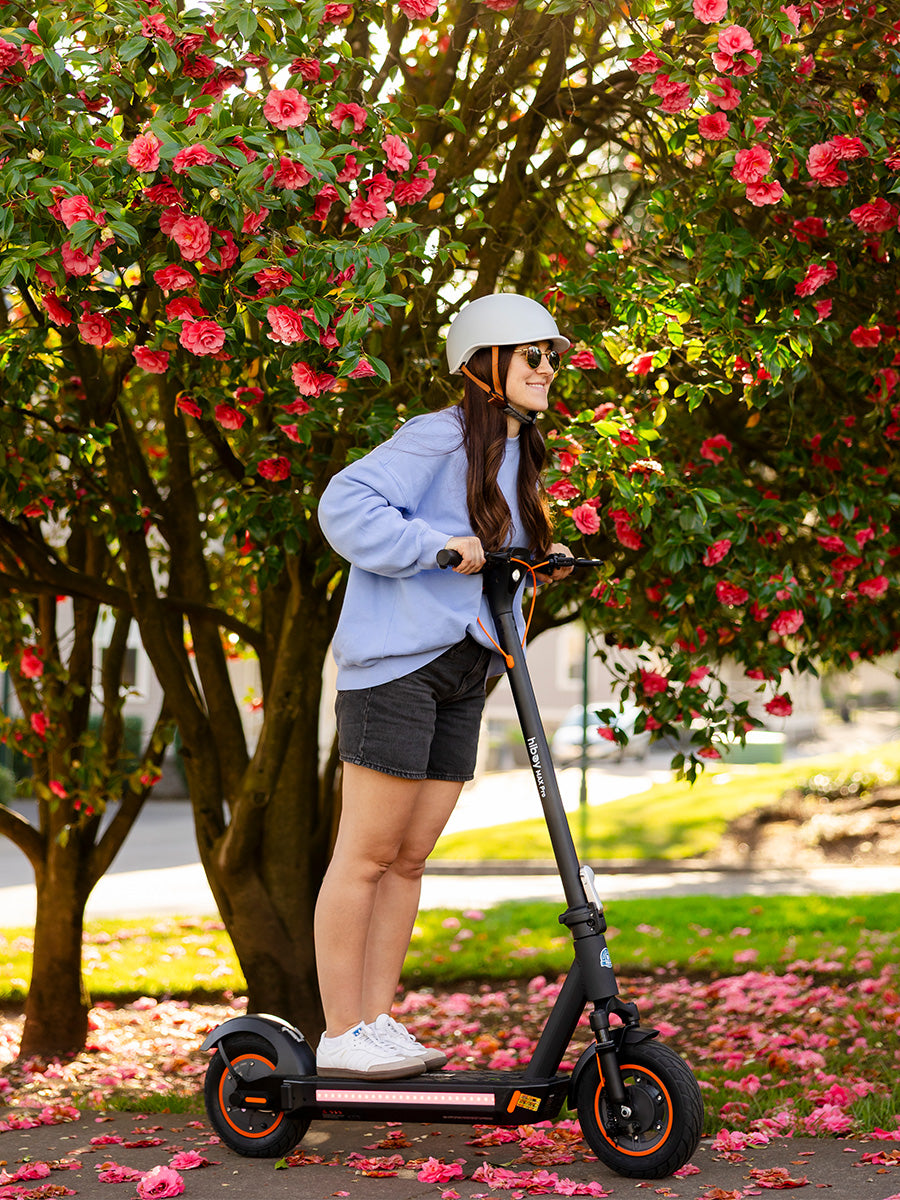


 EX6
EX6
 P6
P6
 C1
C1
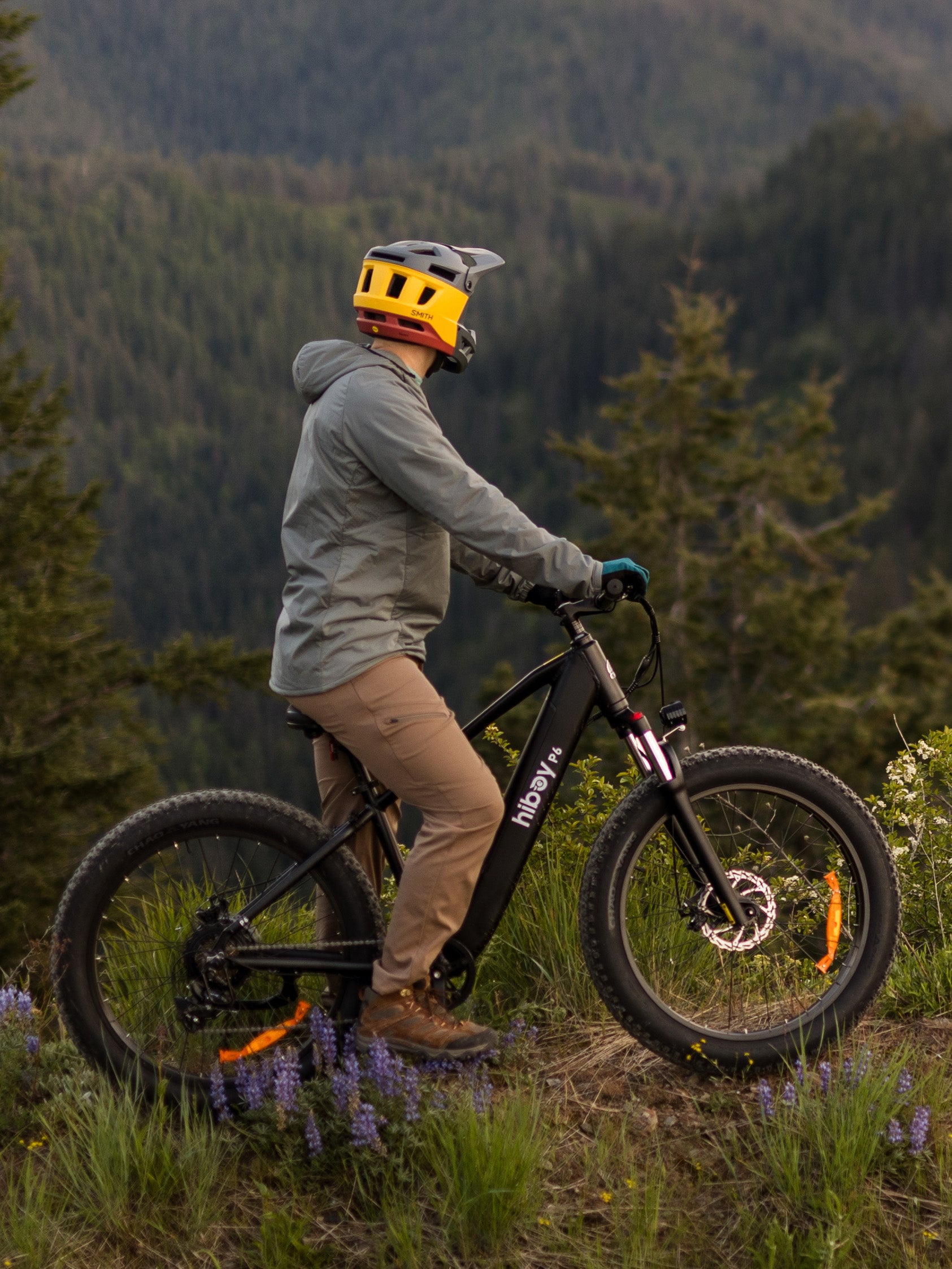
 S2 Lite
S2 Lite
 DK1
DK1
 BK1
BK1

 Q2 Lite-A
Q2 Lite-A
 ES-1
ES-1
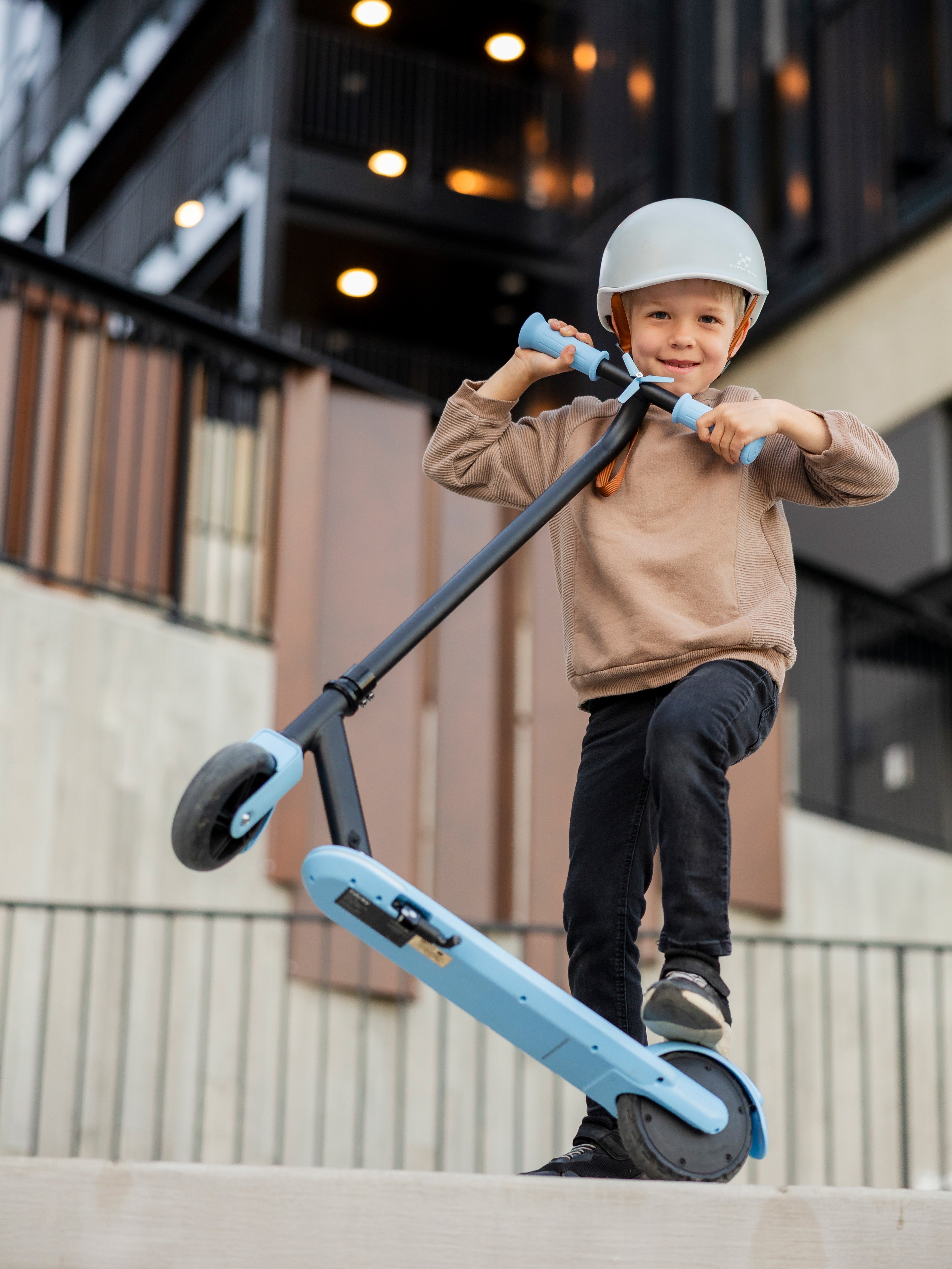
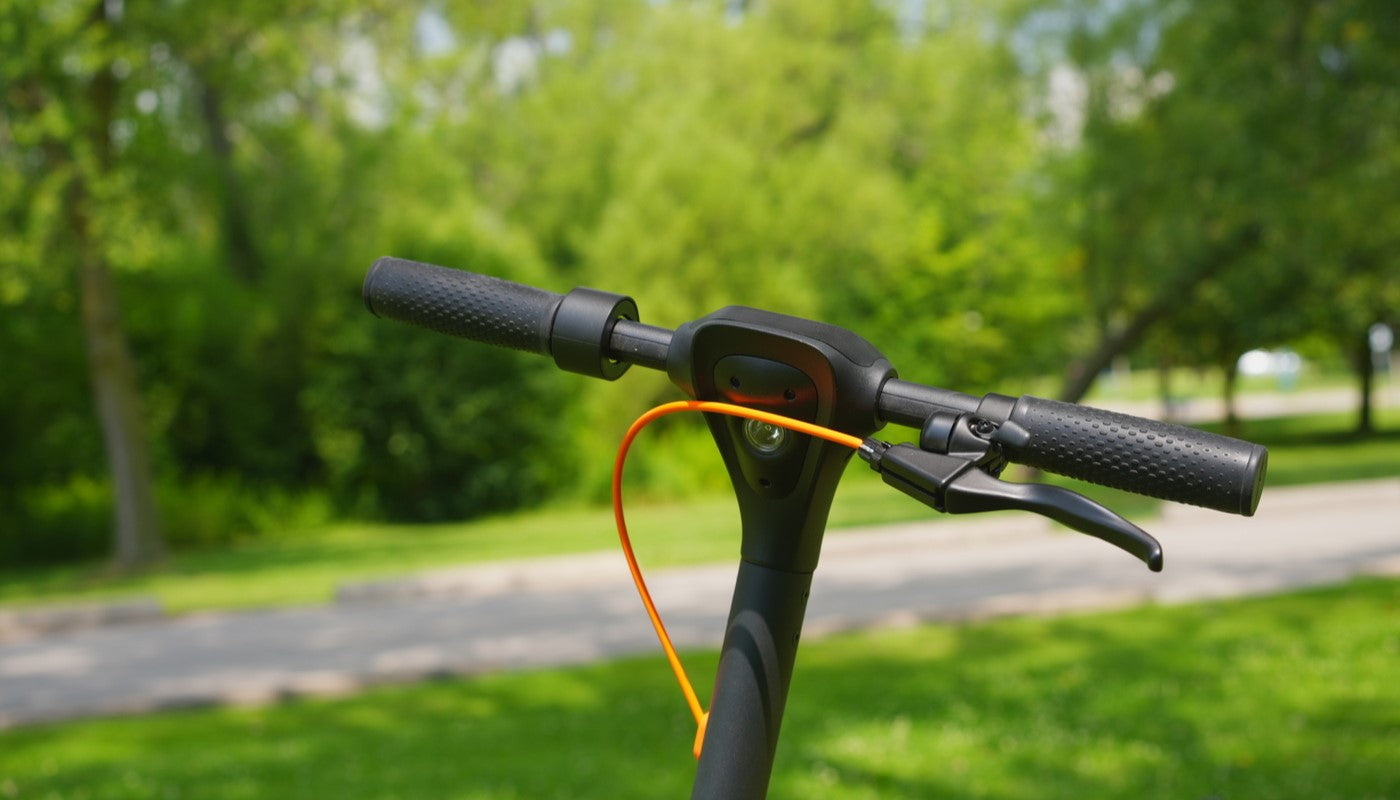
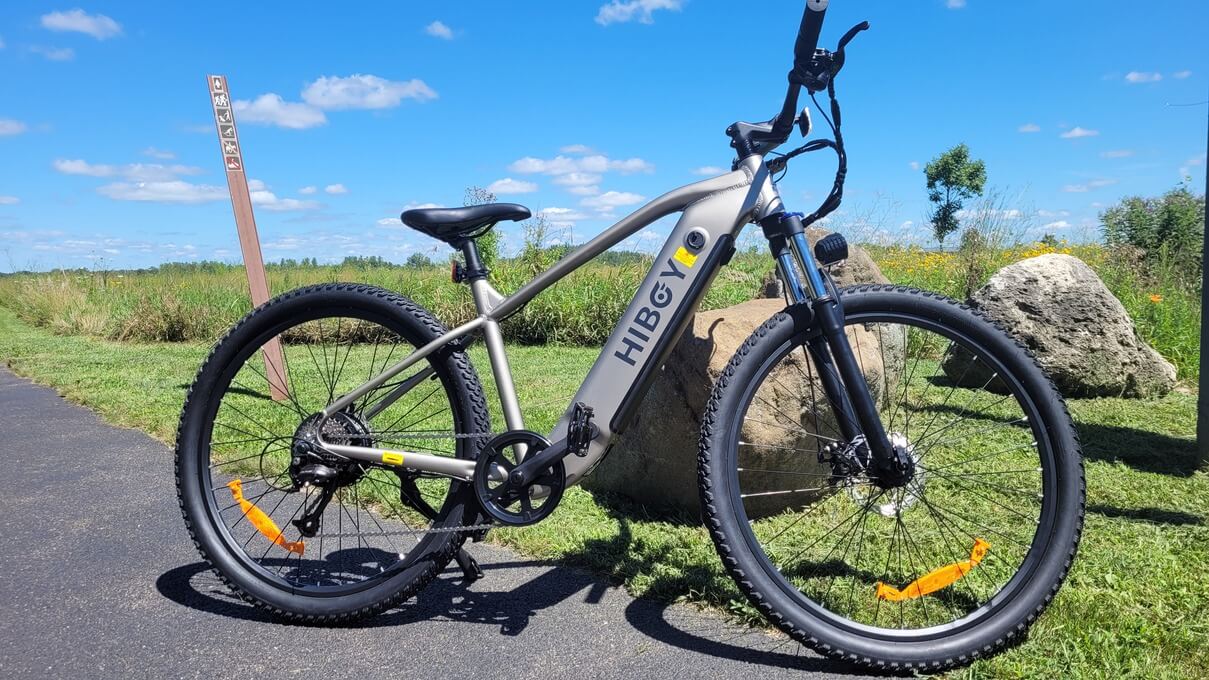
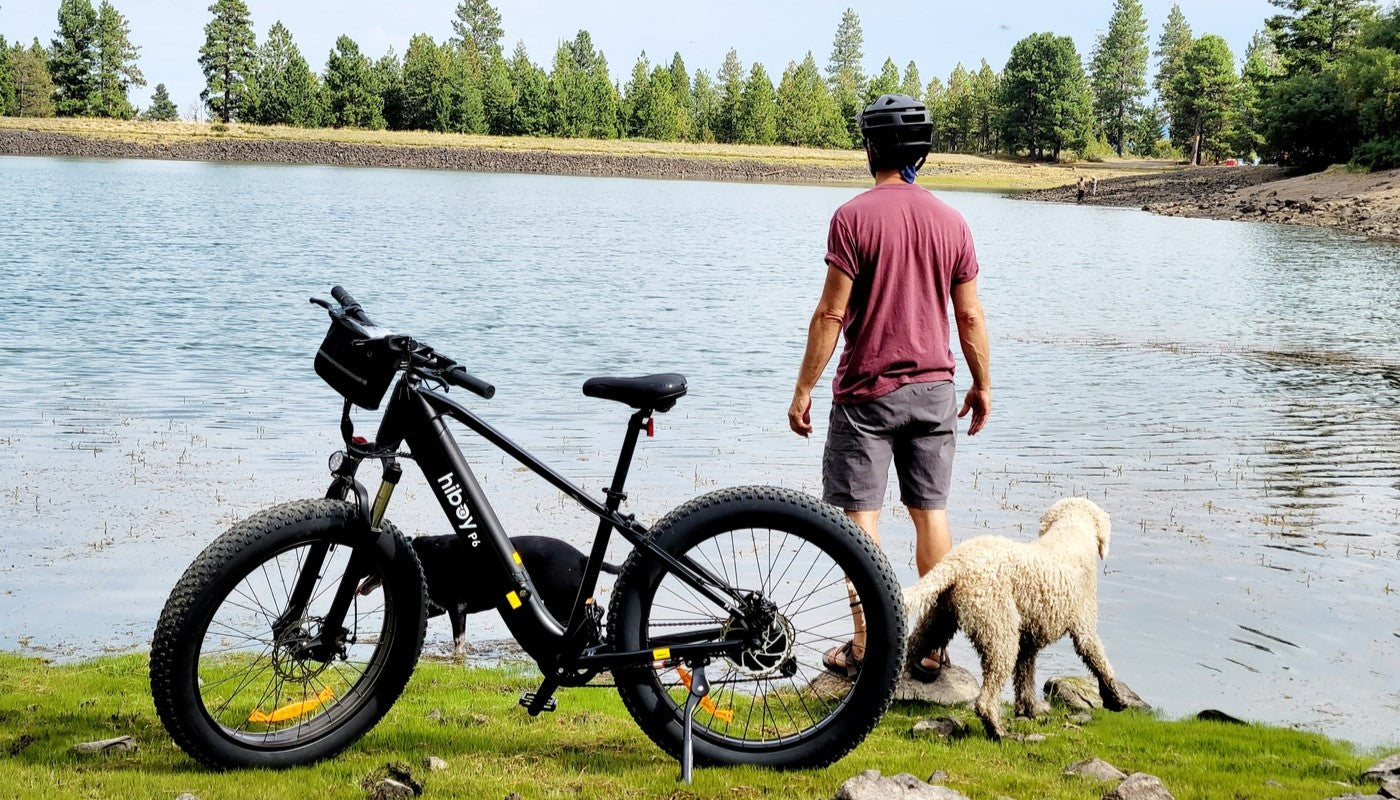






Leave a comment
All comments are moderated before being published.
This site is protected by hCaptcha and the hCaptcha Privacy Policy and Terms of Service apply.